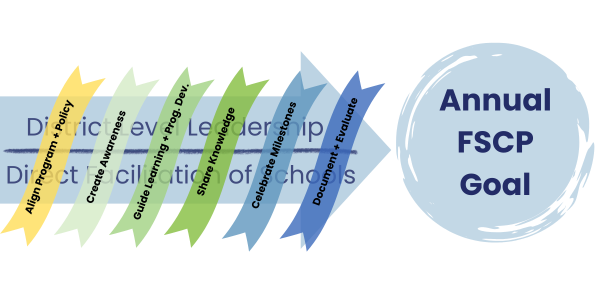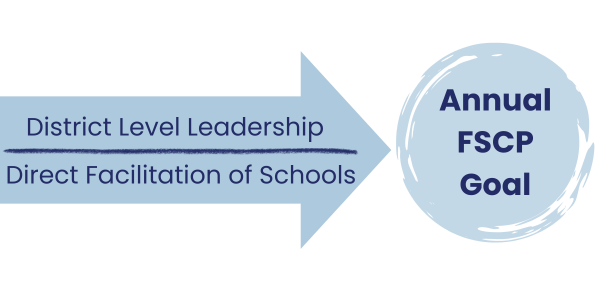You are here
Systemic FSCP for Districts
Introduction: A Research-Based Approach to District-Level
Family, School, and Community Partnerships
District leaders who balance a top-down, ground-up approach to FSCP are likely to see transformative family engagement initiatives at both the district and school levels. District support of school administrators helps foster buy-in for FSCP, leading to welcoming school environments, collaboration with community-based organizations, allocation of funds for FSCP activities, and parent and teacher leadership for FSCP activities (Sanders, 2014). Such an integrated system of support ensures that FSCP efforts are systemic, structured, and sustainable.
The Double Arrow
The double arrow shows how a systemic support structure leads to aligning annual FSCP goals for districts and schools (Epstein et al., 2019). District-level leadership focuses on the practices that FSCP leaders may conduct across the district, while direct-facilitation of schools highlights initiatives that district staff may support at the school-level. Both approaches - top-down with district-level leadership and ground-up with direct-facilitation of schools - ensures that FSCP is integrated throughout the district, benefitting every student and every family.
The Six Strategies for District Leaders
The six strategies for district leaders come from the Lead and Succeed Inventory of District Leadership and Facilitation Strategies for Partnerships (Jansorn & Epstein, 2019). District leaders should use these strategies to guide their district and schools in implementing evidence-based partnership programs. District leaders should consider which strategies align with their annual FSCP goal and include those in their District Implementation Plan. Ideally, district leaders should be working simultaneously on both halves of the double arrow when considering these six strategies: district-level leadership and direct facilitation of schools.
Align Program and Policy: Integrate your district’s FSCP initiatives with district policies, requirements, and procedures.
- Example: Ensure that the district policy on partnerships refers to district level leadership activities and to direct assistance to help all schools develop their partnership programs with goal-oriented action plans.
-
Challenge: Identifying resources (time, staff, funding) to support FSCP policy implementation.
Create Awareness: Actively promote your district’s FSCP initiatives to all key stakeholders, including administrators, teachers, families, and community groups.
-
Example: Conduct presentations about the district’s goals for its partnership program to the school board, parent advisory council, and/or other key leadership groups.
-
Challenge: Securing time in various meetings to share FSCP goals.
Guide Learning and Program Development: Organize and conduct professional development activities to assist schools in developing effective and efficient FSCP initiatives for student learning.
-
Example: Organize a clear process for the district facilitator (e.g., the Family Partnership Contact) to provide feedback and support for each school’s program.
-
Challenge: Incorporating FSCP into school staff’s PD calendar.
Share Knowledge: Foster ongoing communication through the district to build knowledge about research-based and sustainable FSCP strategies linked to student learning.
-
Example: Disseminate a weekly or monthly newsletter that shares important information, upcoming events, and specific school highlights connected with the district’s partnership program, and encourage schools to share with their community.
-
Challenge: Communicating about FSCP in a way that’s not a burden on you or school staff but that keeps FSCP as a proactive school improvement strategy.
Celebrate Milestones: Recognize school and district successes in partnership goals and practices and disseminate the success widely.
-
Example: Send letters to principals thanking them for their support for partnerships.
-
Challenge: Taking the time to celebrate.
Document Progress and Evaluate Outcomes: Collect information to document activities and to assess progress in meeting district FSCP goals, and assist each school to document and evaluate progress in implementing their Unified Improvement Plans.
-
Example: Establish a quarterly or monthly recordkeeping system for the district facilitator(s) to document visits to schools and technical assistance that is provided or requested.
-
Challenge: Determining how to best measure FSCP outcomes.

Use the buttons below to explore the two halves of the Double Arrow in more depth.




Connect With Us





